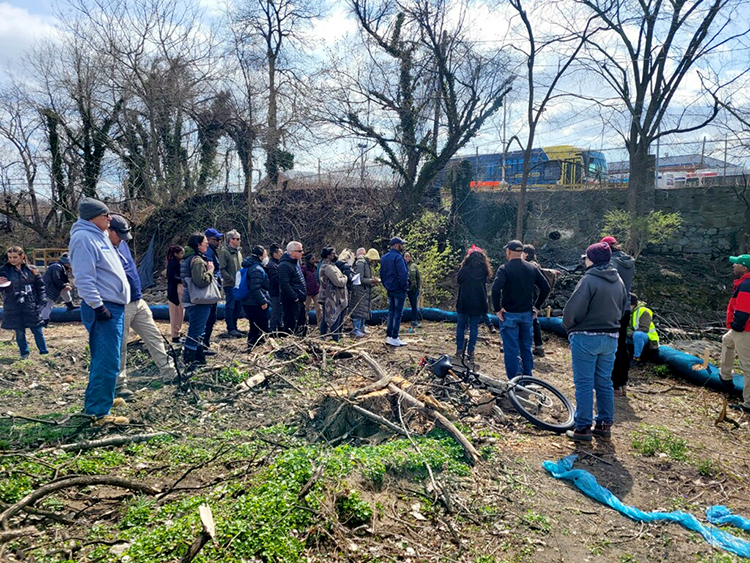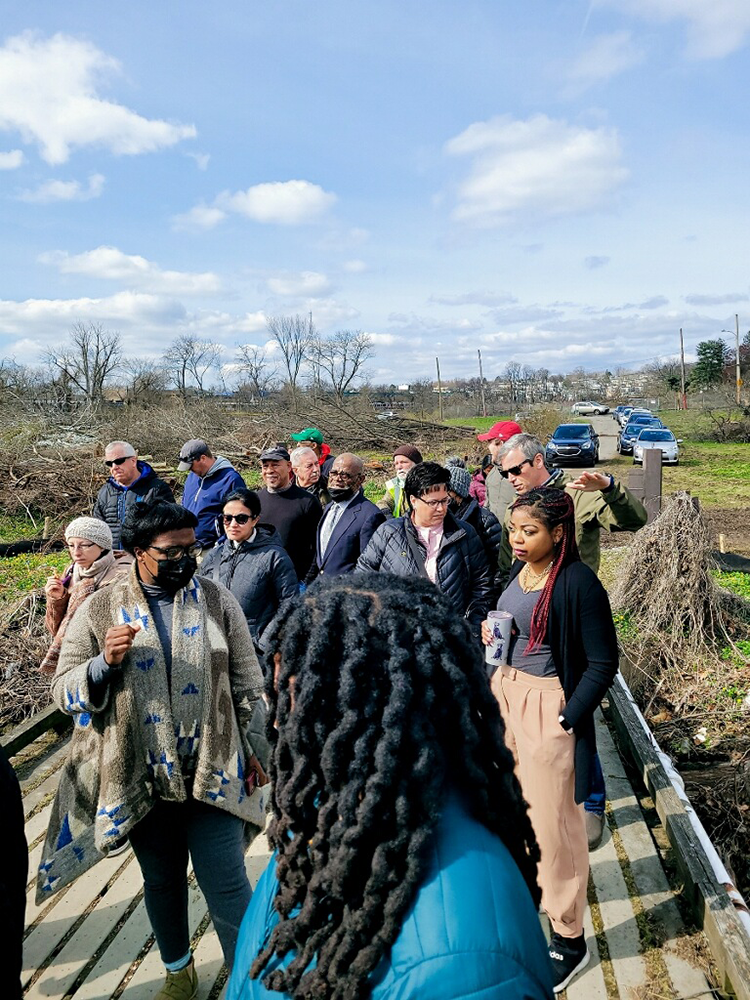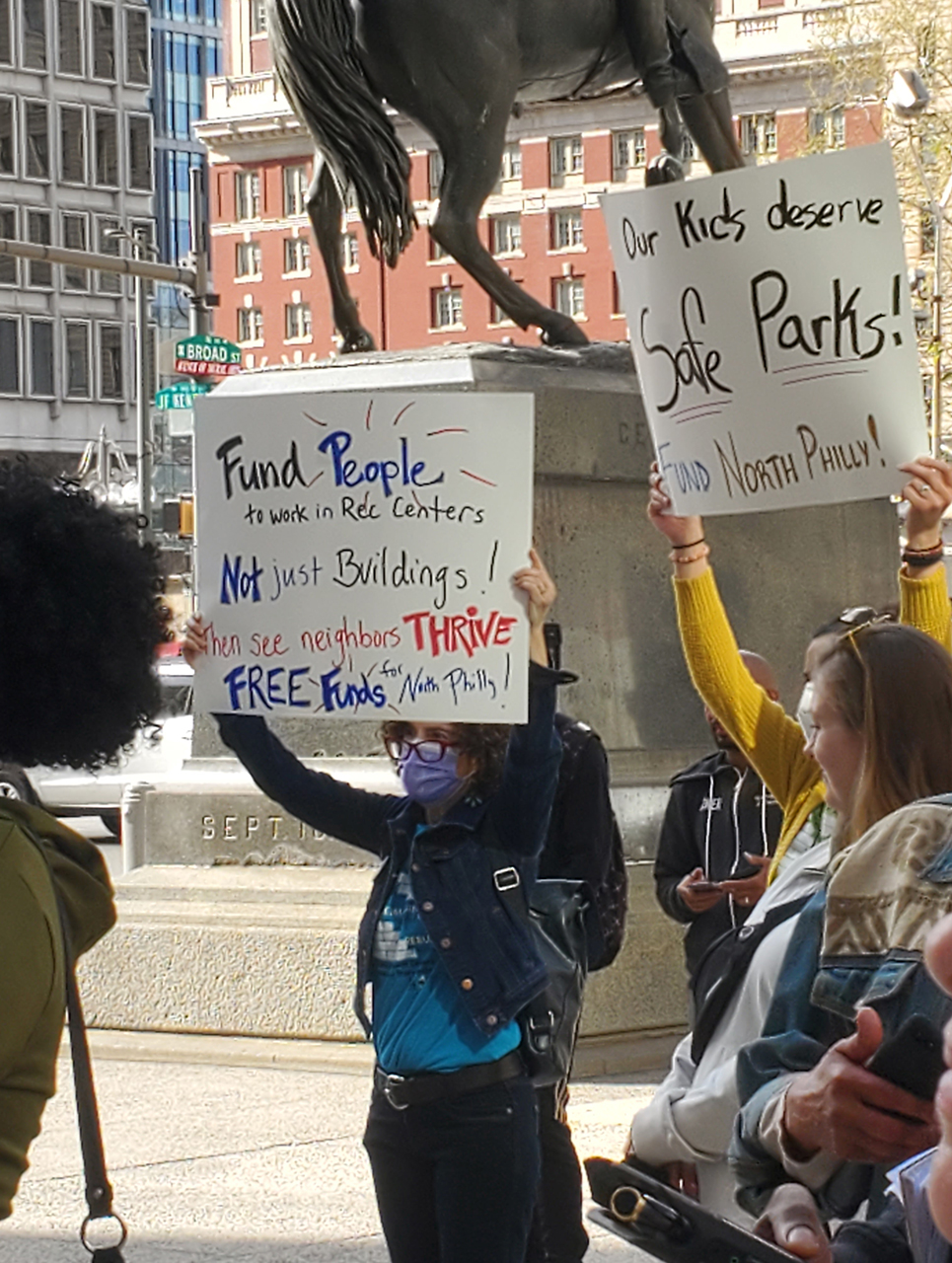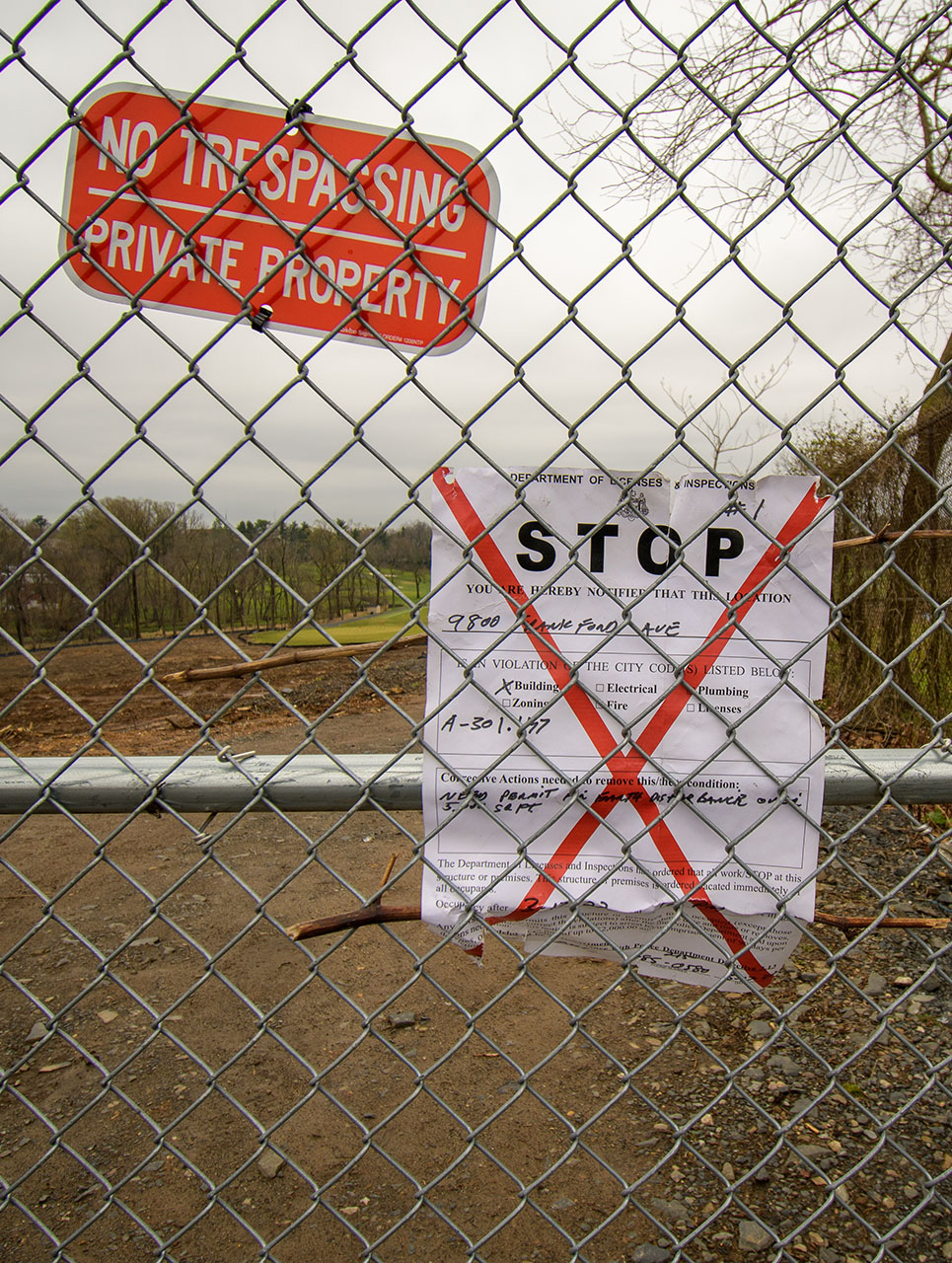The sun shone bright on a landscape cross-hatched with felled trees on a walking tour of the Cobbs Creek Golf Course on April 4. The Cobbs Creek Restoration and Community Foundation, the organization overseeing the revamping of the golf course, had the trees cut down, said Dana Henry, the tour guide and a spokesperson with the Cobbs Creek Ambassadors Program. The ambassadors encourage volunteers, ideally local residents, to adopt and help maintain sections of Cobbs Creek Park.
“The trees have been clear cut all the way to City Line Avenue,” said Henry, standing within sight of SEPTA’s 69th Street Transportation Center. “This tour will give you an idea of the results,” she told the approximately 45 participants. They included community members, environmentalists, Philadelphia Parks & Recreation commissioner Kathryn Ott Lovell and City Councilmember Curtis J. Jones Jr., along with some of his staff. Jeff Shanahan, president of the Cobbs Creek Foundation and other foundation employees also took the tour, as did Maura McCarthy, executive director of the Fairmount Park Conservancy.

Some attendees remarked on changes before the tour began.
It’s heartbreaking to see these trees cut down.”
-Simone Scott, neighbor of Cobbs Creek
“It’s heartbreaking to see these trees cut down,” said Simone Scott, who has lived nearby for many years. “I have a stepson, 11, who’s always on his phone, but he liked coming here. It was gorgeous.”
Miguel Chavarria’s memories stretch back even farther. “I grew up near 60th and Market,” said Chavarria, 69. “We would walk to the creek, swim in the creek. Now it’s devastated. It’s as if the area was raped. It wasn’t necessary what they did. Somebody jumped the gun.”

When the tour began, Henry led the group to Indian Creek, a tributary of Cobbs Creek. “The banks are collapsing because the trees that anchored them were cut,” she explained. “The banks need to be stabilized. I’ve stood out here in storms and seen them be washed away.”
Shanahan mentioned efforts to shore up the banks.
“We left the stumps in to help stabilize the banks,” he said, “and we’ve put socks [mesh tubes about one foot in diameter packed with what looks like wood chips] along the bank. We’re leaving the stumps in. Nobody’s going to take out the stumps. We also can put in used Christmas trees here to help prevent erosion.”
Changes in the waterway go beyond the bank, another Cobbs Creek Ambassador pointed out.
“Invasive plants like duckweeds have begun to grow [along Indian Creek]” he said. “That’s not good for the stream bank.”
Henry also called attention to another area where once free-flowing water had become stagnant.
“The foundation is spending $15 million to fix the creek,” said commissioner Ott Lovell.
Even so, the foundation stands to gain, noted tour participant and near neighbor Timothy Reimer.
“With the foundation claiming a cost of $15 million for the creek restoration and getting $15 million in DEP [Pennsylvania Department of Environmental Protection] credits, $800,000 from the NFWF [National Fish and Wildlife Foundation] and $3 million from the city, that leaves them coming out ahead a minimum $3.8 million on the creek restoration,” Reimer said.
Other possible grants for restoring the creek could boost that gain to as much as $6.8 million, he noted.
As Henry led the group to higher ground for an overview, one participant asked if a plan had been developed for the area.
“We submitted a plan in 2020,” Shanahan said, “but it wasn’t complete.”
The participant asked why trees were cut down with the plan unfinished.
“It was 90% complete,” Shanahan said.
Yet, there’s still no final plan on record, Henry noted.
Another participant asked if, given that Cobbs Creek is a public area, meetings open to the public were held to discuss the plans.
“We had more than 100 meetings to tell the community about the plans,” a foundation spokeswoman said. Questioned further, she said that in some cases only one person attended the meetings.
“Send us your questions,” she added. “We’ve responded to everything that’s been submitted to us.”
“I’ve sent emails,” said a tour participant and member of the Overbrook Park Civic Association, “but my concerns were never addressed.”
From the higher ground, one could see better the clearcut patches amounting to 100 acres of once-forested land. “There was black walnut, sycamore, oak and maple, many of them 80 years old or older,” she said.
“The cutting included heritage trees [large, exemplary trees considered irreplaceable],” said Cobbs Creek environmentalist Lawrence Szmulowicz. “Those woods provided habitat for a pair of great horned owls and pileated woodpeckers. They’re protected by the Migratory Bird Treaty Act. I’m not aware of any efforts to take their protected status into consideration [when the trees were cut].”
“I’ve lived about a mile from here all my life,” said Steve Lockard, 73, who often takes part in Cobbs Creek cleanups. “[The clearcutting] was too much, too soon.”
“They’ve called for my resignation [because of the clearcutting],” Ott Lovell mentioned to a companion, “but it’s going to take more than this to bring me down.”
As the tour crossed Cardington Road, some attendees noted that there was no sidewalk, but neighbors often cut across the golf course to reach their destination. The proposed fence around the golf course would force people to walk at the edge of the road near traffic.
Councilmember Jones, whose district includes the golf course, agreed.
“Number one, the first saw should never have hit a tree without a complete plan,” Jones said. “Now we have to work to mitigate what’s happened. What can be done to replace trees. Give us recommendations to prevent further damage.”
Some participants promised to do so.
Maura McCarthy, of the Fairmount Park Conservancy, which works to care for the city’s parks, suggested that work on the creek bank could bring unexpected benefits.
“The creek bank [nearest SEPTA] could be restored in a way that helps remove heavy metals that might come from the [adjacent] bus maintenance facility,” she said.
Henry concurred with the necessity of a solid plan.
“We need to put together a protection plan,” she said, when the group stood on the other side of Cardington Road. “We’re hoping for an opportunity to maintain valuable trees. Trees that remain on the creek bank are more vulnerable now. Trees affect our daily quality of life. It will be hotter without them.”
Neighbors spoke of the loss of intangible benefits, too.
“It was wonderful just to get away and relax here,” said Karen Moore, who has lived near North 75th (near Haverford Avenue) for 20 years. “It was so peaceful when the trees were here.”
Henry pointed to a swath of magnificent felled trees and said: “This feels like Exhibit A. I don’t want this to ever happen again in the City of Philadelphia.”










It seems like residents would have enjoyed this more as a public park than a golf course. Lots of comments of folks just going there to enjoy nature.
I cpmpletely agree with you………I hope the residents of Cobbs Creek continue to organize and fight back against those who did this…..and also the City officials whose responsibility it is to protect our green spaces…
This golf course will be a huge blessing to the city and it’s residents. There are plenty of other parks for the cities residents. Golf teaches kids valuable life lessons. Can’t wait to see the many life success stories to come from the restored course!
Why I am not surprised that a financial advisor from West Chester doesn’t mind that a hundred acres of city park land were illegally clear cut.
Absolutely! And a tiny percentage of the area’s citizens percentage play golf. How many kids will play will learn the valuable life lessons (or rather parents) be able to pay for those valuable lessons). I played for years and iloved it –my father taught me. He could afford it!!!